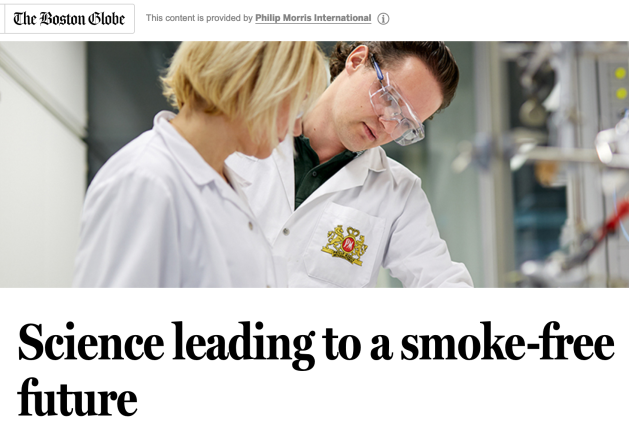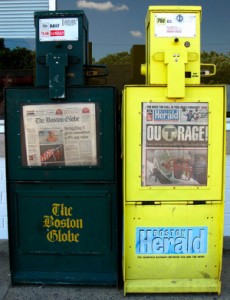
More than two decades after cigarette ads began disappearing from newspapers, major news organizations are running ads on their websites from tobacco giant Philip Morris touting the company’s research into smoke-free tobacco products.
I began reporting this piece after an alert reader called my attention to an ad in The Boston Globe titled “Science leading to a smoke-free future,” which appeared over the weekend and was in rotation as recently as Monday. But in Googling around, it didn’t take long to find that similar Philip Morris ads have been published by The New York Times, The Washington Post and Reuters. No doubt they’ve appeared in many other outlets, too.
These are not ads that were automatically served up to news websites by Google. Rather, they are sponsored content, produced in collaboration with the news organization that publishes them. Such content, also known as “native advertising,” use type and layout that differ from the typical presentation. It’s also accompanied by disclosures that it was paid for by the advertisers and that the news and editorial departments had no involvement in its production.
Regular readers know that I’m a defender of native ads as long as there is sufficient disclosure, and I have no problem with the way these news organizations handle them. But partnering with a major tobacco company on an ad promoting research into tobacco products? Really?
Become a member of Media Nation for just $5 a month. Members receive a weekly newsletter with exclusive early content.
These ads appear under the byline of Dr. Moira Gilchrist, vice president of strategic and scientific communications at Philip Morris. Some excerpts from the Globe version:
We are now on a path to one day, hopefully soon in many countries in which we operate, completely replace cigarette sales with smoke-free alternatives that are a better choice for the people around the world who smoke today. These are nicotine-containing products that do not burn tobacco, which — while not risk-free — are a much better choice than continuing to smoke….
The fundamental principle that drives our scientific work is the widely accepted fact that nicotine — while addictive and not risk-free — is not the primary cause of smoking-related disease. It’s the burning of tobacco that creates the harmful chemicals in cigarette smoke — which is why from the outset we design our smoke-free products to eliminate burning, thus eliminating smoke while providing an alternative that smokers find acceptable and will actually use.
According to Michael Moore of Australia’s George Institute for Public Health in Australia, and a past president of the World Federation of Public Health Associations, the Philip Morris ads are the latest in a series of tactics by Big Tobacco to win acceptance for e-cigarettes. In an article he wrote last year for the European Journal of Public Health, he identified other tactics employed by the tobacco companies as “use of the term ‘harm reduction,’” social-media attacks on critics, hiring lobbyists, and touting e-cigarettes as a method for quitting smoking. According to a summary of his article:
Tobacco companies face an ever-increasing rate of marginalisation. They use eCigarettes as an opportunity to improve their credibility. In the past it was “just filter it” and “light cigarettes”. More recently, Philip Morris established a “Foundation for a Smoke-free World” pumping millions of dollars into distorting arguments about harm reduction.
And, yes, Moore gives Gilchrist a shoutout: “To enhance arguments, Big Tobacco has deployed public health figures like Dr Derek Yach and Dr Moira Gilchrist.”
When I asked Megan Arendt, a spokeswoman for the anti-tobacco organization Action on Smoking and Health (ASH), about the Philip Morris ads, she told me by email: “In a perfect world, vapes would only be marketed to (and sold to) adult people who smoke. But given their clear history of targeting children, an ad ban should include all tobacco products.”
The Philip Morris ad doesn’t promote smoking or even vaping, which has its own health risks. (On Monday, Juul reached a $40 million settlement with North Carolina over a lawsuit charging that the vaping company marketed to kids. Massachusetts is suing as well.) But the ad does talk about “ensuring our smoke-free products deliver a consistent aerosol” — so the intended user of the products being developed would still be inhaling.
Cigarette advertising is legal in U.S. newspapers. The papers couldn’t be banned from accepting such ads because of First Amendment protections, but the tobacco companies themselves could be prohibited from advertising. In 1970, President Richard Nixon (yes, everything really does go back to Nixon) signed legislation banning cigarette ads from television and radio, but those are regulated media.
The New York Times banned cigarette ads in April 1999, but said the policy didn’t apply to other papers it owned, which at that time included the Globe. That July, the Globe’s then-ombudsman, Jack Thomas, took his bosses to task and called for the Globe to follow the example set by the Times and other papers. He wrote that “publishers are still in conflict, still seduced by the revenue from tobacco ads but also uneasy in the role of a siren luring readers into a deathtrap.”
My research trail went cold after I found the Thomas piece, but at some point the Globe stopped accepting cigarette ads, as did virtually all other newspapers. As ASH’s Arendt says, the Globe — and every media outlet — should take the next step and refuse to accept ads for tobacco products. Claims that the products are only intended for adults who want a safer alternative to smoking are nice, but you know what? They’ll find those products without the complicity of news organizations.



